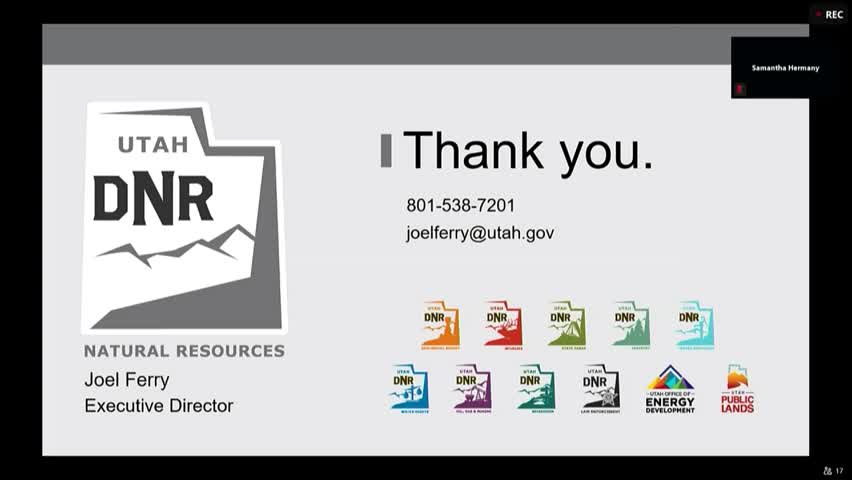Utah Energy Office Reports on Workforce Development and Education Initiatives
September 16, 2025 | 2025 Utah Legislature, Utah Legislature, Utah Legislative Branch, Utah
This article was created by AI summarizing key points discussed. AI makes mistakes, so for full details and context, please refer to the video of the full meeting. Please report any errors so we can fix them. Report an error »

In a meeting held on September 16, 2025, the Utah Legislature's Public Utilities, Energy, and Technology Interim Committee gathered to discuss pivotal developments in the state's energy landscape. The atmosphere was charged with anticipation as committee members reviewed ongoing negotiations regarding a significant energy contract, emphasizing the sensitive nature of the discussions. Co-chair representatives urged members to direct any inquiries privately to the involved directors, highlighting the importance of confidentiality in these negotiations.
The conversation quickly shifted to the historical significance of energy production in Utah, particularly referencing a power plant that once provided substantial benefits to the state, including hundreds of jobs. As the plant's influence waned, committee members expressed a renewed commitment to harnessing its remaining capacity—1,900 megawatts—as a bridge to future energy solutions.
Mary Parkinson, an energy specialist from the Utah Office of Energy Development (OED), presented an update on the state's energy education initiatives. Established under House Bill 157, the Energy Education and Workforce Development Advisory Group aims to enhance energy literacy among K-12 students. Parkinson noted a concerning gap in students' understanding of energy sources and the careers available in the industry.
Since its inception, the advisory group has met monthly, fostering collaboration between educators and industry professionals. Parkinson reported that OED has reached 20,000 students in the past year, a significant increase from the previous year, and is actively working to extend its outreach beyond the Wasatch Front to rural areas.
Despite the progress, Parkinson acknowledged barriers such as the cost of educational materials and the need for better alignment with state energy policies. However, she also highlighted opportunities for improvement, including the development of educator checkout kits and plans for educators to visit energy facilities. These initiatives aim to bridge the gap between theoretical knowledge and practical application, ensuring that future generations are well-equipped to enter the energy workforce.
As the meeting concluded, the committee members expressed their appreciation for the ongoing efforts to enhance energy education and the importance of maintaining Utah's energy production capabilities. The discussions underscored a collective commitment to not only preserving existing resources but also preparing the next generation for a dynamic energy future.
The conversation quickly shifted to the historical significance of energy production in Utah, particularly referencing a power plant that once provided substantial benefits to the state, including hundreds of jobs. As the plant's influence waned, committee members expressed a renewed commitment to harnessing its remaining capacity—1,900 megawatts—as a bridge to future energy solutions.
Mary Parkinson, an energy specialist from the Utah Office of Energy Development (OED), presented an update on the state's energy education initiatives. Established under House Bill 157, the Energy Education and Workforce Development Advisory Group aims to enhance energy literacy among K-12 students. Parkinson noted a concerning gap in students' understanding of energy sources and the careers available in the industry.
Since its inception, the advisory group has met monthly, fostering collaboration between educators and industry professionals. Parkinson reported that OED has reached 20,000 students in the past year, a significant increase from the previous year, and is actively working to extend its outreach beyond the Wasatch Front to rural areas.
Despite the progress, Parkinson acknowledged barriers such as the cost of educational materials and the need for better alignment with state energy policies. However, she also highlighted opportunities for improvement, including the development of educator checkout kits and plans for educators to visit energy facilities. These initiatives aim to bridge the gap between theoretical knowledge and practical application, ensuring that future generations are well-equipped to enter the energy workforce.
As the meeting concluded, the committee members expressed their appreciation for the ongoing efforts to enhance energy education and the importance of maintaining Utah's energy production capabilities. The discussions underscored a collective commitment to not only preserving existing resources but also preparing the next generation for a dynamic energy future.
View full meeting
This article is based on a recent meeting—watch the full video and explore the complete transcript for deeper insights into the discussion.
View full meeting

